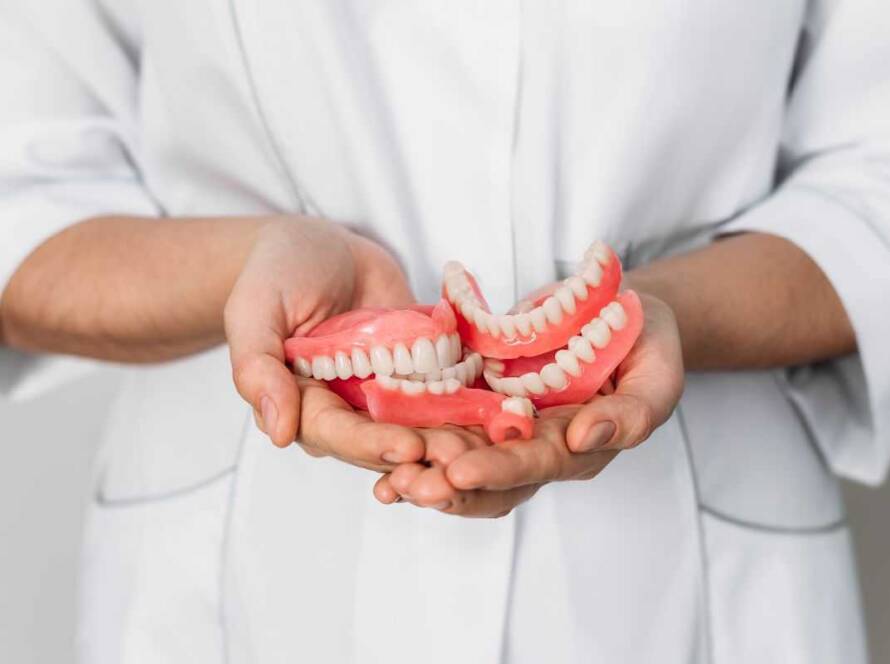
Losing a tooth can throw you off more than you might expect. Suddenly, your bite feels different, your smile looks unfamiliar, and even simple things like laughing or chewing can make you feel self-conscious.
If that sounds familiar, you’re not alone. Millions of people experience tooth loss every year, whether from injury, decay, or gum disease.
The good news is that modern dentistry offers a solution that doesn’t just replace the tooth, but restores how your smile feels and functions. Dental implants have become the gold standard for long-term tooth replacement, blending strength, comfort, and natural appearance in a way that’s hard to tell apart from the real thing.
In this article, we’ll walk you through what dental implants are, how they work, who’s a good candidate, and what you can expect from the process.
Key Takeaways
- A dental implant replaces a missing tooth root with a titanium post, fused to bone, topped with a crown.
- In the U.S., implant prevalence among people missing at least one tooth rose from ~0.7 % in 1999 to ~5.7 % by 2015–16.
- Modern dental implants have success rates around 95–98 % over many years.
- Not everyone is a candidate — factors like bone volume, overall health, smoking, and gum disease affect eligibility.
What Is a Dental Implant?
A dental implant is more than just a fake tooth, it’s a carefully engineered root replacement, usually made of biocompatible titanium (or sometimes ceramic), surgically placed into the jawbone to act as an artificial tooth root. Over time, the bone grows and fuses to the implant in a process called osseointegration, creating a stable foundation. Attached to that is an abutment, a connector, and finally, a crown (or prosthetic tooth) that looks and functions much like your natural teeth.
Because implants integrate with bone, they help preserve jawbone density (preventing the “sunken” look that often follows tooth loss) and prevent nearby teeth from shifting.
Why Choose Implants Over Other Options?
When replacing missing teeth, your options may include bridges, dentures, or implants. Implants offer unique advantages:
- Bone preservation: Unlike dentures or bridges, implants help stimulate bone and slow resorption.
- No impact on adjacent teeth: You don’t have to grind down neighboring teeth (as with bridges) to support the replacement.
- Longevity: With proper care, implants can last decades or a lifetime. Many studies report success rates between 95–98 % over 10 or more years.
- Natural feel and function: People often say implants “feel like your own teeth” — you can chew, speak, and clean as you would natural teeth.
- Increased confidence & quality of life: Restoring a full smile helps with self-esteem, socializing, and head posture.
How Common Are Dental Implants?
While still not universal, dental implant use has been increasing significantly in the U.S. Among individuals missing at least one tooth, the prevalence of implants rose from about 0.7 % in 1999 to 5.7 % by 2015–2016. The growth has been especially pronounced in older adults, between 2009 and 2016, those aged 65–74 saw the largest absolute increase in implant prevalence.
Each year, roughly 500,000 new implants are placed in the U.S. as more people and dentists adopt this solution. The U.S. dental implant market is large and growing, currently valued at over USD 1.5 billion, with projected growth rates in the 10 %+ range.
These numbers tell us two things: more patients are seeking durable, natural-feeling tooth replacements, and the technology is becoming more accepted and available, yet barriers (cost, bone health, awareness) remain.
Who Is a Good Candidate?
Not everyone is immediately eligible for implants, but many more people than you might think can qualify. Here’s what dentists typically assess:
- Bone volume & density: Implants need enough healthy bone. If your jaw bone has resorbed (shrunken), bone grafting may be necessary.
- Overall health: Chronic conditions such as uncontrolled diabetes or immune disorders may affect healing.
- Oral hygiene: Healthy gums and good hygiene are crucial, gum disease must be managed first.
- Smoking: Tobacco use can reduce success rates.
- Habits & bite force: Clenching or grinding (bruxism) can stress implants and require careful planning.
Your dental provider will evaluate via imaging (CT scans, X-rays) and a clinical exam to determine whether implants are feasible, or whether preparatory treatments are needed first.
Implant Process: Step by Step
Let’s walk through what you can expect (rough timeline with empathy built in):
- Consultation & planning
We’ll review your medical/dental history, take 3D images, and map out the ideal implant position — so your new tooth fits beautifully. - Surgical placement of implant
The titanium post is inserted into the jawbone under local anesthesia (sedation options available for comfort). - Healing / Osseointegration
Over 2–6 months, your bone gradually fuses to the implant. You often wear a temporary crown during this period. - Abutment placement & final crown
Once integrated, the abutment is attached, and your custom prosthetic tooth is placed, shaped and shaded to match your natural teeth. - Maintenance & follow-up
Good oral hygiene, regular checkups, and periodic monitoring are essential to ensure long-term success.
The entire process may take several months, but each step is planned and executed to maximize comfort, function, and aesthetic outcomes.
Risks, Complications & Success Rates
Any surgery carries some risk, but dental implants are considered a safe and predictable option. As the FDA explains, complications may occur early (surgical site, infection) or later (implant loosening, peri-implantitis).
Research suggests that 10-year success rates are typically above 97 %, while longer-term rates remain very high in well-maintained cases. In some studies, failure rates are reported around 3–5 % under optimal conditions.
Risk factors that may reduce success include:
- Poor bone quality or insufficient bone
- Active gum disease or poor oral hygiene
- Smoking
- Systemic health issues interfering with bone healing
Your dentist will walk through these risks with you candidly, ensuring you understand benefits, trade-offs, and how we minimize risk through planning and follow-up.
Costs & Insurance Considerations
We understand: cost is a real concern. Dental implants are more expensive upfront than bridges or dentures, but they often deliver superior long-term value.
- In the U.S., the dental implant and abutment market is valued at USD 1.5+ billion and projected to keep rising.
- A single implant (post + abutment + crown) may cost several thousand dollars depending on complexity, materials, surgeon skill, location, and preparatory work needed (like grafts).
- Some dental plans may cover a portion (often under “major services”), but many exclude implants entirely.
- Multiple practices (including ours) offer financing options or payment plans to make treatment more manageable.
During your consultation, we’ll provide a transparent breakdown of your costs, alternatives, and payment options, no surprises, just clarity.
Why Choose Humble Memorial Dental for Your Implants
When it comes to replacing missing teeth, you deserve more than just technical skill; you deserve a team that listens, cares, and makes the process as comfortable as possible.
At Humble Memorial Dental, we bring together:
- Compassion-first approach: From your first call to dental implant placement tx, you’ll be treated gently, without pressure or judgment.
- State-of-the-art technology & planning: We use advanced imaging and guided planning to maximize precision and safety.
- Comfort & sedative options: For those with dental anxiety, we provide sedation and techniques to keep you comfortable.
- Transparent communication: We explain every step in plain language, so you feel in control of your oral health.
- Financing & insurance help: We work with major insurance carriers and offer flexible payment plans to make implants more accessible.
In short: when you entrust us with your smile, we take it personally. Our goal is that years later, your implant still feels natural, and so does your experience.
Final Thoughts
A dental implant isn’t just a cosmetic fix, it’s a long-term investment in your health, function, and confidence. With success rates over 95 % and benefits like preserved bone, stable biting, and a natural feel, they’re often the best option when teeth are missing.
Of course, implants aren’t suitable for everyone, so candid evaluation, clear planning, and good maintenance are essential. If you’re in or near Humble, TX, and considering implants, Humble Memorial Dental is here to guide you with empathy, transparency, and care every step of the way.
Have questions or are ready to explore your options? We’d love to help you take that next step, comfortably and confidently.
Frequently Asked Questions (FAQ)
1. Can dental implants get cavities?
No — the implant material (titanium or ceramic) doesn’t decay like natural tooth enamel. However, surrounding gum tissue can still develop disease (peri-implantitis), which requires care.
2. How long does a dental implant last?
Implants are designed for longevity. Many last 20+ years or even for life when cared for properly. Crown or restoration parts might need replacement over time.
3. Is the implant process painful?
We use local anesthesia and optional sedation to minimize discomfort. After surgery, you may feel soreness, swelling, or mild discomfort, similar to a tooth extraction, for a few days.
4. Are implants safe for older adults?
Yes, many older patients are excellent candidates. The biggest factors are overall health, bone quality, and oral hygiene habits.
5. Can everyone with missing teeth get implants?
Not everyone, eligibility depends on bone volume, gum health, systemic health, and habits like smoking. If you don’t qualify immediately, preparatory treatments (grafts or sinus lifts) may make implantation possible later.
6. How soon after extraction can an implant be placed?
In some cases, implants may be placed immediately during extraction (immediate implant). In others, we wait for healing (a few months) before placing the implant, the choice depends on bone condition and case factors.
7. What is “All-on-4”?
All-on-4 is a protocol where a full arch of teeth is supported by just four implants, often enabling quicker restoration and fewer implants overall.








